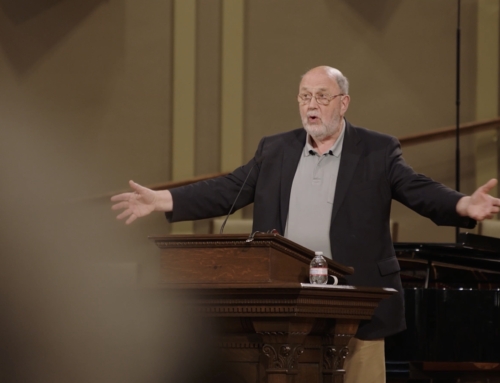For many Christians, we face a problem almost as soon as we begin reading the gospels. What’s with the discrepancies? Why do the gospels differ at specific points? If these are true accounts of Jesus’s life and ministry, as they claim to be, and if they are inspired scripture, as Christians believe, shouldn’t we at least expect agreement in the details?
What did Jesus say on the cross? What about the Roman soldier at the foot of the cross? How many people did Jesus feed with the fish and loaves? Did he cleanse the Temple at the beginning of his ministry, or at the end? The significance we place on these kinds of questions reveals quite a bit about how think of the gospels’ authority and trustworthiness.
Let’s shed some light on the difficulties you may encounter when thinking about the four gospels side by side.
The Problem with Harmony
One of the more common reactions to the gospels’ variations is to try to ‘harmonize’ them. Essentially, some projects attempt to prove that what appears as discrepancies between the texts aren’t actually historical differences.
While this may sometimes be the case (after all, who’s really to say Jesus didn’t feed the 5000 and then, some other time, also feed 4000?), it avoids more significant problems by misplacing the emphasis of our faith on modern assumptions about truth and history, rather than on the story of what Jesus came to do and to teach. Even if we want to say that Jesus fed two giant crowds or that the Roman soldier at the foot of the cross called the dying Jesus both ‘innocent’ and ‘Son of God’, we are still faced, under our modern-day commitments, with why the gospel authors chose to include some things and omit others. These choices shape the narrative and the effect on readers.
This is actually a very old problem. The early Christians weren’t dumb. They recognized the discrepancies we see today. The manuscript history even shows scribes trying to iron out apparent differences well into the Christian era.
Enter Tatian, a theologian of the late 2nd century. Around 160 or 170 A.D., he attempted the first harmonization of the gospels in something called the Diatessaron. It combined the details of the four gospels into a smoothed-out version. Tellingly, this work never caught on. The early church abandoned it, partly because it wasn’t associated with an Apostle. This tells us that the source’s authority and the narrative results were more important than harmony.
This may have to do with the early church’s origin in Jewish styles of thought. Jewish exegesis had long prioritized story over doctrine. There is a stated commitment to preserving the puzzles of the text. But the point is that these disagreements in the details didn’t discredit the testimony of the gospels among the earliest readers. If anything, it bolstered claims, showing that the accounts were not made up and rehearsed. When we think of multiple people conferring to align their stories perfectly, we tend to think of criminals before interrogation, not eyewitnesses to a world-altering event.
Let this be a reminder to us. We can have our modern assumptions about how biographies should be written, but we can only apply these to modern texts since we are modern people with modern assumptions. We must take the gospels in their own contexts and on their own terms. The first readers simply were not concerned with the same questions of detailed historical harmony as we are.
What are the Gospels, Anyway?
If we want to understand why there are variations in the gospel accounts, we have to reframe our idea of what the gospels are doing.
To uncover what the gospels are doing, we must probe the question of genre. The gospels (for the most part) fit into a common Greco-Roman genre of the time called a bios. Think of it kind of like an ancient biography. The structure, scenes, and characters found in the gospels match the conventions of the bios genre, so we at least know the evangelists wanted their readers to read their accounts as biographies.
Importantly, in a bios, the theme was always more important than details like chronology, dialogue, or numbers. For example, Helen Bond points out that ancient bios were often built around the literary strategy of anecdote. We know how anecdote works. It is committed to the essence of a story more than the details. Anyone who’s been to a family dinner knows this. Your grandparents tell the same story every dinner, but the way it is told – the details and emphases – might change slightly over the years. They met during an Intro to Psychology class, or maybe it was Economics? The legendary no-hitter game was on a Sunday, or was it a Saturday? You don’t discredit the story because of these variations. The details aren’t what matters.
The Gospels That Definitely Don’t Agree
We can further see evidence of what the Gospels are doing when we compare our four canonical gospels to what are called the Gnostic Gospels. Many other accounts of Jesus’s life and sayings were floating around in the first few centuries A.D. A few of the more famous examples are the Gospels of Thomas, Judas, Mary Magdalene, Phillip, and the Gospel of Truth. These texts explicitly called themselves ‘secret,’ both because their goal – distinct from Matthew, Mark, Luke, and John – was to reveal ‘hidden’ knowledge and because they weren’t used by most Christians, and were therefore less available.
These texts include many of the same sayings of Jesus that we find in our Bibles, as well as similar characters and references, but in radically different contexts. The result is that the tensions in these texts are not so much about Israel, judgment, Kingdom, and Messiah, but about illusion and enlightenment. Yet the same historical truth lies behind both. Looking at the Gnostics, we can see how multiple authors can take the same basic events (the same words even) and place them into their narratives to produce different results. One of the clearest examples is the Gospel of Thomas, which includes similar or identical sayings of Jesus as what we find in our Bibles, but because they aren’t placed in the context of a narrative about Jesus preaching, healing, and journeying to Jerusalem, end up feeling more like good advice than like good news. On an admittedly smaller scale, this kind of remixing for differing effects is precisely what the canonical gospels are doing also.
Why Four?
From among the many stories of Jesus floating around in the years after his death, the early church chose to canonize just four. Why not validate everything? Why not just one? What about this limited multiplicity was worth preserving? Part of the answer is in how these four texts are written.
The Judeo-Christian tradition is unique because its belief is contained in and communicated through story.
Anthony Le Donne uses social memory theory to explore why and how people remember what they do. Events themselves may be static, but the memory of those events is constructed into a stable narrative by community interaction. Even if a community didn’t get together to decide on what to include and what not, the individual authors are products of their community, and construct with a sensitivity to their particular community’s needs. Different communities have different socio-political, cultural, and psychological needs, motives, and pressures to respond to when constructing these memories, which inevitably lead them to different constructions. Among other things, this reminds us that the gospels are not primarily individual documents. They are formed by and for community.
The form of the gospels suggests this was the case. Memory theorists tell us that there are ideal ways to tell stories we want to remember, especially in oral cultures. The gospels, with their parables and short interactions, have what is called ‘pneumonic stability.’ In other words, they’re easy to remember. In fact, the slight differences in how otherwise identical stories are told across the four gospels might actually have helped people remember the key messages. There’s a bit of a ‘Goldilocks’ effect to remembering stories. You want stories that are simple but not too simplistic; which reflect the complexity of real life but aren’t too convoluted. The gospels are just memorable enough.
Do the Gospels Have an Agenda?
This, finally, leads us to the main point of what the gospel authors are doing. In a recent interview for Relevant Magazine, N.T. Wright suggests we needn’t get hung up on parts of the Bible that don’t align. “Such puzzles seem to miss the point of the texts, which is not to point to themselves but to point to Jesus.”
Today, we’re used to history as a genre that prioritizes supposed agendaless chronicle. But the gospels have an agenda. This may come as a shock. The main objective of the gospels is not to convince us that the gospels are correct. Instead, the main objective of the gospels is to convince us that Jesus is worth following. We Moderns may have expectations about how we would most easily be convinced, which may intersect with historical reliability. Still, we need to leave these expectations at the door when dealing with premodern texts.
Burridge & Alexander show that within the storytelling conventions of the time, all four canonical gospels do, in fact, utilize the elements commonly used for persuasion. Again, they aren’t trying to persuade readers that the events were historically accurate as we think of that concept today. They want to persuade readers that the message and person being conveyed is worth following. This doesn’t mean they ‘made things up’ or were unconcerned with accurate representation. They just weren’t concerned with it in the same way.
This is not a negative statement. Any time you tell a story, you have an agenda. When you tell your spouse how your day went. When you tell a potential employer why you’re the best candidate for the job. When you tell your child why touching a hot stove is a bad idea. All of these stories come with an agenda.
The gospel authors are taking a collection of known stories and sayings, which Jesus, as a traveling preacher, likely repeated multiple times, and rearranging and reshaping them to fit into patterns that will help their readers more easily recognize the grand message being conveyed. As all storytelling does, they are working to craft meaning from an otherwise meaningless string of events. They follow a principle of selection and arrangement that inevitably leads to differences. John says as much at the end of his Gospel when he says that he chose some things to include, but not everything (21:25).
Returning to the example of the soldier at the foot of the cross, what the evangelists choose to have him say fits into the pattern they’ve established and served their specific persuasive goals. This in no way should denigrate the historical validity of the gospels (whatever that may be), nor should it insinuate backroom manipulation. Narrative construction is an inevitability any time we tell a story. This challenges us to rethink our ideas about historical ‘accuracy’ and ‘truth’ when it comes to the gospels, whatever we want to say about the inspiration of scripture or about the historical facts of the Christ event.
Restoring (a kind of) Harmony
We have to face the simple fact that the Gospels don’t align in every detail. This doesn’t, however, discredit a sense of ‘harmony.’ In the English language, we run into the problem of using the same word, ‘gospel,’ to identify both the singular message Jesus proclaimed and the varied texts which chronicle this telling. This gives the misleading allusion that the texts are just as singular as the message. Of course, the message IS singular. There is one essential claim about the Kingdom of Jesus being molded and shaped by the authors for their own contexts and audiences. One message announced four ways. That message is experienced more richly because of this abundance.
That’s the thing about harmony, as any musician knows. It consists in a difference which, taken together, creates something more beautiful. I’m not musical in the slightest, but my wife is a vocalist who loves nothing more than harmonizing. She explains that harmony is like complementary colors in art (I’m not artistic either…). If you have multiple colors or notes and place them alone, they’re fine, but nothing special. If you try to average them out, flatten them into complete agreement, you end up with brown or an unpleasant tone. But if you lay them all side by side in just the right way, existing as coequals, you can produce a beautiful image or song. She reminded me that this is why barbershop quarters sound so good. This is what the gospels are, too—four voices singing their parts alongside each other. The differences do not weaken their song but strengthen it.
There’s nothing wrong with looking at the events of the gospel accounts side by side, but we run into danger when we rest our faith on their internal consistency. The lack of perfect alignment should remind us that Jesus is more than any one portrait of him. This is more than fitting for the man we call God incarnate.
Sources That Informed This Article
Anthony Le Donne The Historiographical Jesus: Memory, Typology and the Son of David (Baylor University Press, 2009)
Bible Project, How to Read the Bible Series, https://bibleproject.com/podcast/series/how-to-read-the-bible-series/
Helen Bond, The First Biography of Jesus: Genre and Meaning in Mark’s Gospel (Eerdmans, 2020)
Jeannine K. Brown The Gospels as Stories: A Narrative Approach to Matthew, Mark, Luke, and John (Baker Academic, 2020)
Loveday Alexander, The Preface to Luke’s Gospel (Cambridge University Press, 2005).
N.T. Wright, Scripture and the Authority of God (HarperCollins, 2013)
Richard Burridge, What Are the Gospels?: A Comparison with Graeco-Roman Biography (Baylor University Press, 2018)
Tyler Huckabee, “What Is the Bible For? A Conversation with N.T. Wright” https://relevantmagazine.com/magazine/what-is-the-bible-for/
Ryan Liguori
Latest posts by Ryan Liguori (see all)
- Why Don’t the Gospels Match? - September 29, 2022
- How to Make the Most of an N.T. Wright Online Course - June 7, 2022
- Three Key Concepts from Prof. Wright’s New Course An Advanced Study in Galatians - May 19, 2022







